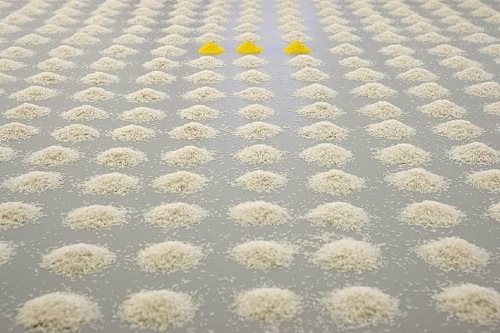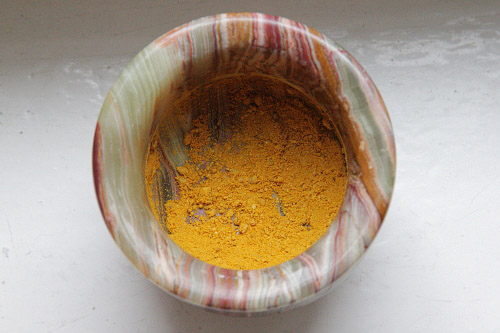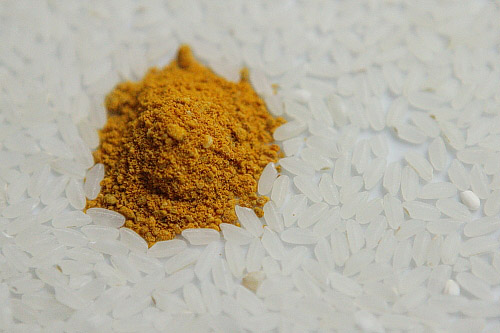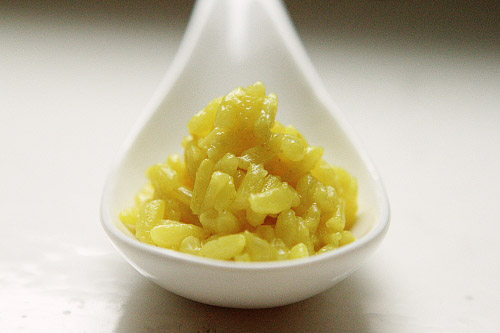Subtleties of taste, texture and tone – a simple meditation on the infinite. Made of rice and pollen meticulously mounded across the floor, Wolfgang Laib’s 2007 work, Ohne Zeit – ohne Ort – ohne Körper, acts as an ephemeral testimony to existence in its rawest forms. Amidst the grid work of rice mountains, the glowing yellow of three central pyramidal piles is strikingly potent – a concentration of hazelnut pollen.

piles of rice, 3 piles of hazelnut pollen, 470 x 410cm, image courtesy Galerie Thaddeus Ropac
Since the early 80s, the artist’s work has blended the libational rituals of India, the seasons of southern Germany and the visual vocabulary of conceptualism. Having collected pollen seasonally over 30 years, Laib’s inclusion of the raw granules in his artwork developed as a means of expressing the finite and infinite alike. Like the rituals of food preparation, Laib follows his skilled diligence of gathering with methodical composition and a tasteful eye for his works’ ultimate reception. Many of his works, including Ohne Zeit – ohne Ort – ohne Körper, which translates to ‘Without time – without place – without body’, center visually on perishable foods like milk, pollen, rice and beeswax, the presentation and eventual dispersal of which, reinforce his meditations on existence.

Why rice, why pollen? Within Laib’s work, the composition of materials is as relevant as their formation. Believing life to be beyond the limits of a physical form, his works’ sculptural simplicity allow his mediums to take on and exhibit their own symbolic natures. In a 2009 interview Laib reflects on his use of pollen and its potential symbolism:
“The pollen is the potential beginning of the life of the plant. It is, I think, as simple, as beautiful and as complex as this. And of course it has so many meanings. But, I think everybody who lives knows this is important.”
– Wolfgang Laib (2009)

In Ohne Zeit – ohne Ort – ohne Körper Laib espouses the nourishing and life-sustaining qualities of rice alongside the potentiality active in pollen. Both mounds, that of rice and that of pollen, are composed of a multitude of particles, yet in comparison the pollen dust suggests the infinite. The merging of so many infinitesimal grains into one color field, particularly the vivid yellow of the pollen, viscerally draws in the viewer’s attention just as the color plays such a central role in attracting bees and pollinators in nature.
Complimenting Laib’s subtle poetics, this recipe seasons a staple of rice with pollen and turmeric to re-imagine a classic and minimalist saffron rice. This dish’s mild flavor readily accompanies spicy and aromatic courses. The pollen and turmeric imbue the rice with a saturated yellow tone that would serve well to complete a meal’s color palette. Plus, eating small quantities of local pollen regularly is said to support resistance against local allergens – pollen the superfood!

Pollen and Turmeric Rice
Yields: 4 servings
1 cup basmati rice
2 cups chicken stock
1 Tablespoon butter
1/2 teaspoon salt
1/2 teaspoon pollen (local if possible)
1/2 teaspoon turmeric
Rinse the rice under cold water in a fine sieve.
Heat medium saucepan over medium heat and add butter until melted. Add rice and stir to coat in butter. Add salt, pollen and turmeric – stirring constantly for just under 3 minutes, do not brown the rice. Add the chicken stock, bring to a boil, cover and reduce heat.
Simmer for 15 – 20 minutes. The chicken stock should be fully absorbed. Serve immediately.
Cassandra Edlefsen Lasch is a Berlin-based art historian and artist advisor active within international contemporary art production and project realisation. Investigating collaboration is central to her work and her recipes are all gluten-free.
………………………………………………..

6 comments
Jenny says:
Feb 11, 2011
Beautiful. Rice mixed with turmeric is showered on the bride and groom as a blessing in Hindu weddings, and also offered to deities.
Rosa says:
Feb 11, 2011
That is a fabulous spice. A very interesting racipe.
Cheers,
Rosa
Tweets that mention Colour Yellow – Wolfgang Laib – Pollen and Turmeric Rice »Feasting on Art -- Topsy.com says:
Feb 11, 2011
[…] This post was mentioned on Twitter by Megan Fizell, Kunst-Fan. Kunst-Fan said: Colour Yellow – Wolfgang Laib – Pollen and Turmeric Rice http://bit.ly/eVR8LE […]
Y says:
Feb 12, 2011
Stunning colour! I love the sense of occasion turmeric or saffron rice brings to the table.
Heavenly Housewife says:
Feb 12, 2011
What an amazing colour! I have never used pollen as an ingredient. I’m kind of curious about how it would taste.
*kisses* HH
howardski says:
Mar 14, 2011
someone sure has some patience! i am constantly experimenting with spices in the kitchen these days. this looks like something i will try next.